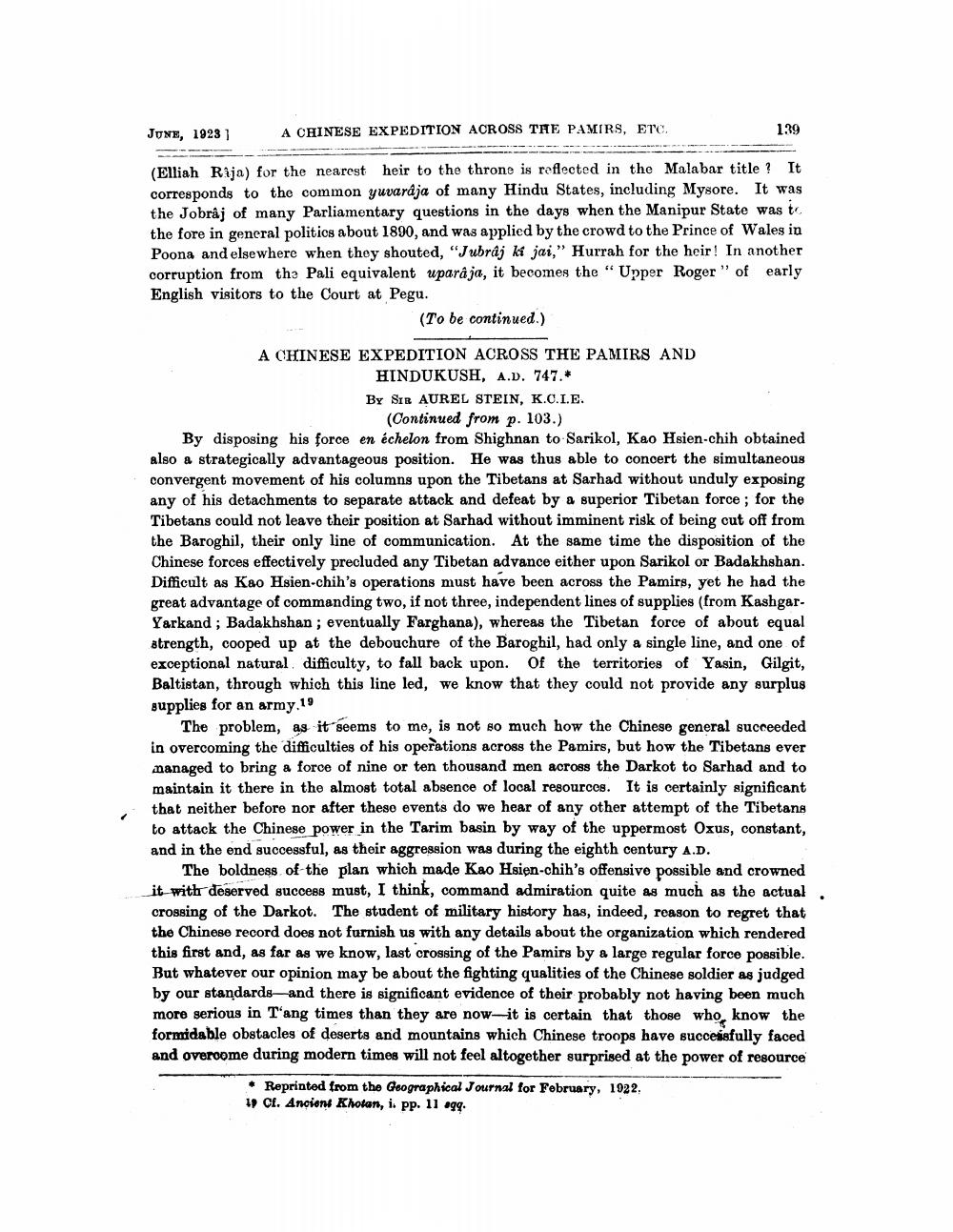________________
JUNE, 1923
A CHINESE EXPEDITION ACROSS THE PAMIRS, ETC.
139
(Elliah Raja) for the nearest heir to the throne is reflected in the Malabar title? It corresponds to the common yuvaraja of many Hindu States, including Mysore. It was the Jobrâj of many Parliamentary questions in the days when the Manipur State was to the fore in general politics about 1890, and was applied by the crowd to the Prince of Wales in Poona and elsewhere when they shouted, "Jubraj Ki jai," Hurrah for the heir! In another corruption from the Pali equivalent uparâ ja, it becomes the "Upper Roger" of early English visitors to the Court at Pegu.
(To be continued.)
A CHINESE EXPEDITION ACROSS THE PAMIRS AND
HINDUKUSH, A.D. 747.* BY SIR AUREL STEIN, K.C.I.E.
(Continued from p. 103.) By disposing his force en échelon from Shighnan to Sarikol, Kao Hsien-chih obtained also a strategically advantageous position. He was thus able to concert the simultaneous convergent movement of his columns upon the Tibetans at Sarhad without unduly exposing any of his detachments to separate attack and defeat by a superior Tibetan force ; for the Tibetans could not leave their position at Sarhad without imminent risk of being cut off from the Baroghil, their only line of communication. At the same time the disposition of the Chinese forces effectively precluded any Tibetan advance either upon Sarikol or Badakhshan. Difficult as Kao Hsien-chih's operations must have been across the Pamirs, yet he had the great advantage of commanding two, if not three, independent lines of supplies (from KashgarYarkand; Badakhshan; eventually Farghana), whereas the Tibetan force of about equal strength, cooped up at the debouchure of the Baroghil, had only a single line, and one of exceptional natural difficulty, to fall back upon. Of the territories of Yasin, Gilgit, Baltistan, through which this line led, we know that they could not provide any surplus gupplies for an army,19
The problem, as it seems to me, is not so much how the Chinese general succeeded in overcoming the difficulties of his operations across the Pamirs, but how the Tibetans ever managed to bring a force of nine or ten thousand men across the Darkot to Sarhad and to maintain it there in the almost total absence of local resources. It is certainly significant that neither before nor after these events do we hear of any other attempt of the Tibetans to attack the Chinese power in the Tarim basin by way of the uppermost Oxus, constant, and in the end guccessful, as their aggression was during the eighth century A.D.
The boldness of the plan which made Kao Hsien-chih's offensive possible and crowned it with deserved success must, I think, command admiration quite as much as the actual crossing of the Darkot. The student of military history has, indeed, reason to regret that the Chinese record does not furnish us with any details about the organization which rendered this first and, as far as we know, last crossing of the Pamirs by a large regular force possible. But whatever our opinion may be about the fighting qualities of the Chinese soldier as judged by our standards and there is significant evidence of their probably not having been much more serious in Tang times than they are now-it is certain that those who know the formidable obstacles of deserts and mountains which Chinese troops have successfully faced and overoome during modern times will not feel altogether surprised at the power of resource
• Reprinted from the Geographical Journal for February, 1022, 19 Cf. Ancioni Khotan, i. pp. 11 -99.




